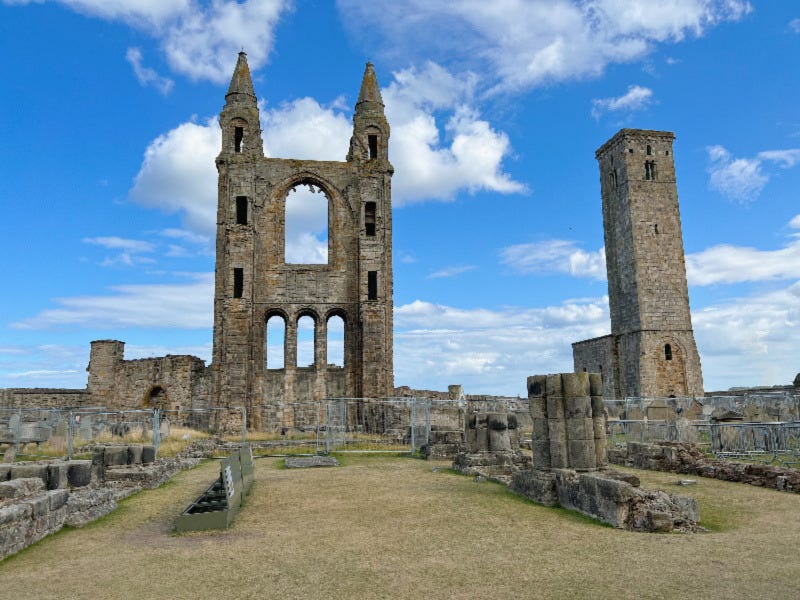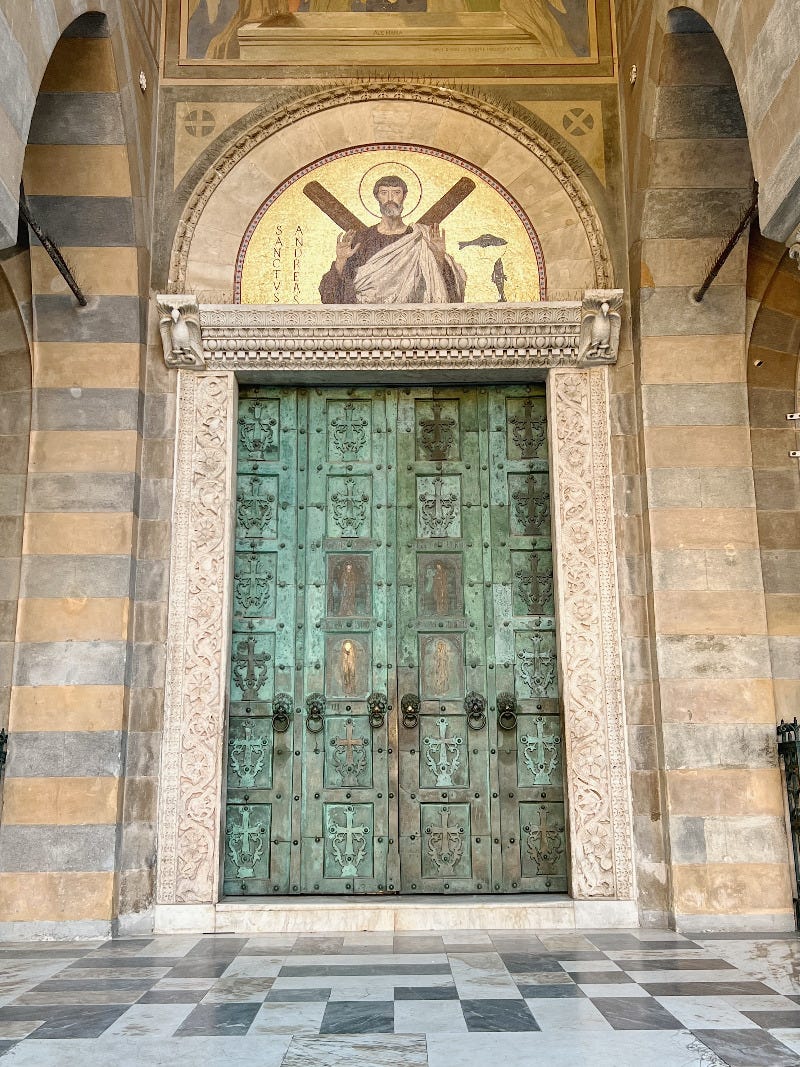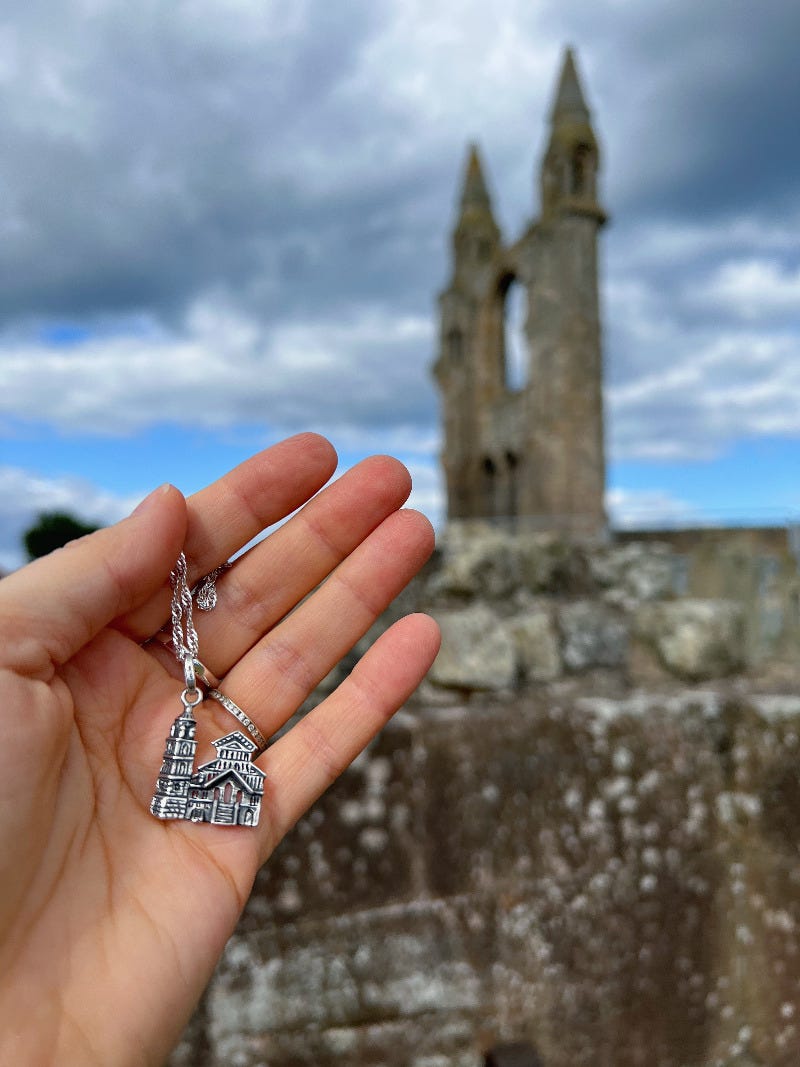On the Road ... to St. Andrews
Exploring the unexpected connection between Amalfi and Scotland.
This summer while planning my trip to Scotland with my mom, at the very top of my must see list was St. Andrews. While I’m sure I’d fall for any college city by the sea and I’ve always been intrigued by golf in a P.G. Wodehouse sort of way, there was another reason I wanted to see St. Andrews for myself. The reason lies in the very name of the place: St. Andrew. Today, on this festival day for Sant’ Andrea—St. Andrew—in Amalfi, read on to find out more about my town’s unexpected connection to Scotland.
In the wheres, whens, and house of saints and relics, there are often many good stories and just as often even more questions. How did Amalfi’s patron saint also become the patron saint of Scotland? Why is there a town called St. Andrews and why is the great cathedral of St. Andrews there in ruins? I certainly had my questions.
Last August, we set off from our home base in the beautiful Perthshire countryside for a short drive to the eastern coast of Scotland. To the Kingdom of Fife to be precise. (A good start to a story, eh?) After strolling through town, where the streets still follow the medieval layout, and a stop for tea, we arrived at the ruins of St. Andrews Cathedral.
Much like Amalfi, the town of St. Andrews has a fascinating history - and it wasn’t golf that first put it on the map. In the Middle Ages this was the seat of the Scottish Church and its great cathedral was the largest and most important in the country. This wealthy ecclesiastical town was dominated by the cathedral and nearby St. Andrews Castle, which is also in ruins. This is the setting, but how did St. Andrew become associated with this place on the craggy coastline of Scotland? A little refresher: Andrew was the brother of St. Peter and one of the Twelve Apostles, who was martyred on an X-shaped cross in Patras, Greece. Not exactly around the corner.
Among the various foundation legends there appears a man named St. Rule, a monk in Patras, who under divine direction took some of the relics of St. Andrew and set off “to the ends of the earth.” Which, as it turns out, was a particularly scenic spot in Scotland. His ship was wrecked along the shore nearby and this was the place where the relics remained. While a little high seas adventure always makes for a good story, it’s more probably that the relics were brought to St. Andrews from England in the early 8th century by one Bishop Acca.
However they arrived, the relics put the newly created burgh on the map. The pilgrimage map that is. On the spot where legend says St. Rule arrived a grand church was built in the 11th-century. The over 100-foot tall St. Rule’s Tower from that church still stands. (Unfortunately, it was closed for safety reasons when we visited.) This impressive tower would have guided pilgrims to the church, and indeed it became one of the most important pilgrimage routes in Christendom - similar to the shrine to St. James in Santiago de Compostela in Spain. St. Andrew’s popularity grew so much that he eventually was adopted as the patron saint of Scotland. With all these pilgrims, a much larger cathedral was required.
Construction on the new cathedral began about 1160 close to St. Rule’s and grew into an enormous complex surrounded by a wall. While it took about 150 years to complete, the finished cathedral was a masterpiece of medieval architecture. Walking through the ruins you can follow the size of the original nave and transept - and it was massive. When completed, it was almost the size of the great medieval cathedrals of England, like York Minster and Durham Cathedral.
-Look at the windows change from right to left. (Photo by Bryan Woolbright on Unsplash)
The soaring east gable of the cathedral gives a sense of the impressive scale. While little remains to imagine its original splendor, there is enough to see that the cathedral’s construction took place during the transition from Romanesque to Gothic styles. Starting from the east gable and looking down the remaining wall to the western side you can see the style moving from rounded arches and sturdy designs to more ornate pointed arches.
You may have noticed the ruins look like a cemetery, which they have been since the 1600s. It was slightly disorienting to walk through the ruins where there’s still all the elements that give you the distinct sense of being inside a church while walking through an outdoor cemetery. And there aren’t just a few tombstones - there are over 1,700! After the Reformation, the abandoned area was used as a graveyard well into the 20th century. We spent time wandering through the tombstones, the cathedral priory, and what was once the chapter house, where the business of the great cathedral took place. Canons of the church sat in stone seats around the chapter house walls, which we discovered created the most incredible echoes.
So what happened to St. Andrews Cathedral? During the tempestuous days of the Scottish Reformation in the 16th century, the cathedral and relics of St. Andrew were obvious targets as such important symbols of the Catholic church. When John Knox, a Scottish minister and leader of the Reformation, preached a particularly passionate sermon in the cathedral, a mob of followers ransacked and burned the cathedral. What relics there were of St. Andrew were lost.
Although the cathedral walls have fallen, St. Andrew is still considered the patron saint of Scotland and St. Andrew’s Day is celebrated widely on November 30th. There’s even a reminder of St. Andrew right on the Scottish flag with its white cross, or saltire. The X-shaped cross is a symbol of St. Andrew, and you’ll see it in several places around Amalfi too.
-Mosaics of Sant’ Andrea above the 11th-century bronze doors of Amalfi’s cathedral.
So that takes us back to Amalfi. On May 8, 1208, relics of St. Andrew were brought to Amalfi from Constantinople (by way of Rome) by Cardinal Pietro Capuano. Why Amalfi? (I would love to have been a fly on the wall when that decision was made.) The short answer seems to be that Capuano was from Amalfi, but there’s surely much more of a story there. Amalfi’s beautiful Duomo, largely as we see it today, was built after the relics arrived, including a sumptuously decorated crypt. While the golden days of the republic of Amalfi have long since passed, you can still walk down the steps into the crypt and see the final resting place of at least some of the relics of St. Andrew.
-Sant’ Andrea procession in Amalfi, November 2019.
Yet the saint’s connection to Scotland remained strong and in 1879 the Archbishop of Amalfi sent a large piece of the shoulder relic to St. Mary’s Catholic Cathedral in Edinburgh where they’re now in the National Shrine of St. Andrew, created as a successor to the shrine at St. Andrews Cathedral that was destroyed during the Reformation. Then, in 1969, a second relic was given by Pope Paul VI to the new Scottish cardinal Gordon Joseph Gray, the first Scottish cardinal in 400 years.
-Reliquary statue of Sant’ Andrea in Amalfi’s cathedral, November 29, 2022.
As I hit send on this newsletter, on November 30th, the church bells are ringing out over Amalfi for the festival of Sant’ Andrea. On this St. Andrew’s Day in Amalfi, I’m remembering my day in St. Andrews, Scotland, and a continued connection between two seaside towns and one very special saint.
-My necklace of Amalfi’s cathedral at the ruins of St. Andrews Cathedral in Scotland.
MORE INFORMATION
St. Andrews Cathedral is free to visit, but (when open) there’s a fee to climb St. Rule’s Tower and to visit the museum on site.
St. Andrews Castle is located nearby and admission is required to enter.
In Amalfi, be sure to visit the Cathedral and Museo Diocesano. You can see the Cloister of Paradise, museum, crypt and the cathedral with only a small entrance fee.
The festival of Sant’ Andrea in Amalfi takes place each year on June 27th and November 30th. The procession down the cathedral’s grand staircase is impressive to see in person - especially when they run the statue of Sant’ Andrea back up the steps!
KEEP READING …
I haven’t seen the Shrine to Saint Andrew in Edinburgh yet, but it’s on my list to see. (Tsk tsk that article didn’t mention the relics came from Amalfi.)
Back in 2011, I wrote about the November Festival of Sant’ Andrea in Amalfi over on my blog Ciao Amalfi.
A few more fascinating facts about St. Andrew.
















Wher is the statue of ST. ANDREW in amalfi put after the feast celebration ? Can it be viewed when visiting amalfi ?